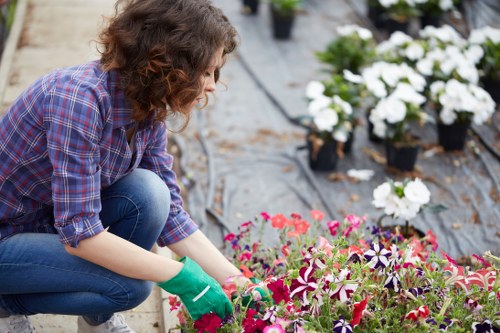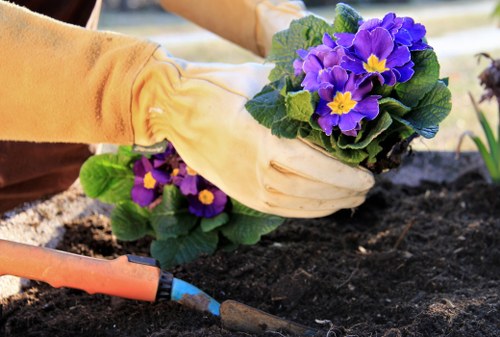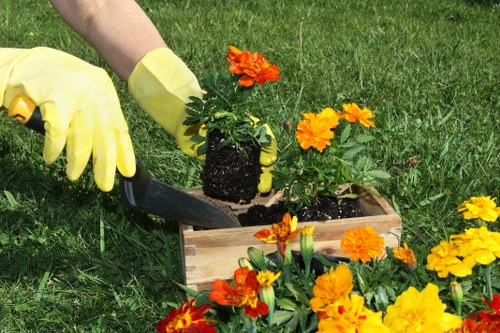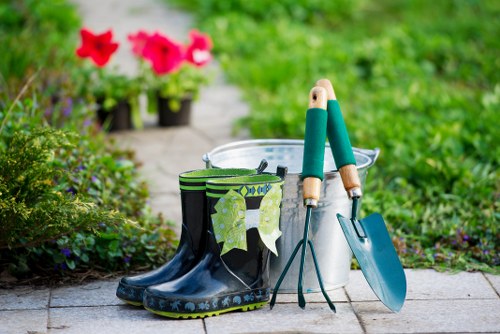Garden Fence Installation in Aperfield: A Comprehensive Guide

Installing a garden fence in Aperfield is a fantastic way to enhance the beauty, security, and functionality of your outdoor space. Whether you have a sprawling backyard or a modest garden, the right fence can add value to your property and provide a sense of privacy and safety.
In this guide, we'll walk you through everything you need to know about garden fence installation in Aperfield. From choosing the perfect materials to understanding local regulations, we've got you covered.
Let's dive into the essential aspects of garden fence installation to help you make informed decisions for your home.
Why Choose a Garden Fence for Your Aperfield Property?

A garden fence serves multiple purposes beyond just defining the boundaries of your property. Here are some compelling reasons to consider installing a fence:
- Privacy: Create a secluded space where you can relax without worrying about onlookers.
- Security: Deter intruders and keep pets and children safe within your garden.
- Aesthetics: Enhance the visual appeal of your garden with stylish fencing options.
- Property Value: A well-installed fence can boost the overall value of your home.
- Boundary Marking: Clearly define the limits of your property to avoid disputes with neighbors.
Understanding the benefits of a garden fence will help you choose the right type and style that suits your specific needs.
Choosing the Right Material for Your Garden Fence

One of the first decisions you'll make when installing a garden fence is selecting the appropriate material. The material you choose will affect the fence's durability, maintenance, appearance, and cost.
Wood Fences
Wood is a classic choice for garden fencing, offering a natural and timeless look. It's versatile and can be customized with different stains and paints.
- Pros: Aesthetic appeal, customizable, relatively easy to work with.
- Cons: Requires regular maintenance to prevent rot and decay, susceptible to pests.
Metal Fences
Metal fences, such as wrought iron or aluminum, are known for their strength and longevity. They offer a more formal and elegant appearance.
- Pros: Durable, low maintenance, adds value to property.
- Cons: Can be more expensive, limited customization compared to wood.
Vinyl Fences
Vinyl fences are a popular modern option, known for their low maintenance and wide range of styles and colors.
- Pros: Highly durable, easy to clean, resistant to weather and pests.
- Cons: Higher initial cost, limited repair options if damaged.
Composite Fences
Composite fences blend the best features of wood and vinyl, offering durability with a natural appearance.
- Pros: Durable, low maintenance, eco-friendly options available.
- Cons: Can be expensive, color may fade over time.
Choosing the Best Material for Your Needs
Consider factors such as budget, desired aesthetics, maintenance preferences, and the specific requirements of your garden when selecting a fence material. Each material has its own set of advantages and drawbacks, so weighing these will help you make the best choice.
The Garden Fence Installation Process

Proper installation is crucial to ensure the longevity and effectiveness of your garden fence. Here's a step-by-step overview of the installation process:
1. Planning and Permits
Before you begin, check with the Aperfield local council to determine if you need any permits for fence installation. Understanding local regulations will help you avoid any legal issues.
2. Measuring and Marking
Accurately measure the area where the fence will be installed. Mark the locations for fence posts to ensure even spacing and alignment.
3. Digging Post Holes
Use a post hole digger to create holes for the fence posts. The depth and width of the holes will depend on the fence type and height.
4. Setting the Posts
Place the fence posts in the holes and fill them with concrete to provide stability. Ensure that the posts are level and aligned properly.
5. Installing Fence Panels or Rails
Attach the fence panels or rails to the posts using appropriate fasteners. Make sure each section is securely fastened and evenly spaced.
6. Finishing Touches
Add any additional elements such as gates, decorative features, or paint to complete the installation. Inspect the fence for any adjustments needed.
Maintenance Tips
Regular maintenance, such as cleaning, painting, or sealing, will help preserve the fence's appearance and functionality over time.
Local Regulations and Permits in Aperfield

When installing a garden fence in Aperfield, it's essential to be aware of local regulations and requirements. Here's what you need to know:
Height Restrictions
Local councils often have specific height restrictions for residential fences. Ensure your fence complies with these limits to avoid any legal issues.
Boundary Agreements
If your garden fence borders a neighbor's property, you may need to reach an agreement regarding the fence's location, type, and maintenance responsibilities.
Permit Requirements
Depending on the fence's height and location, you might need a permit from the Aperfield council. Always check with local authorities before starting installation.
Material Restrictions
Some areas have restrictions on the types of materials you can use for your fence. Make sure your chosen material is permitted in your neighborhood.
Historical or Conservation Areas
If your property is in a historical or conservation area, there may be additional guidelines to preserve the area's character.
Consequences of Non-Compliance
Failing to adhere to local regulations can result in fines, the need to modify or remove the fence, and potential disputes with neighbors.
Consulting Professionals
To ensure your garden fence installation complies with all local laws, consider consulting with a professional installer or contacting the Aperfield council for guidance.
Top 15 Nearby Areas to Aperfield for Garden Fence Installation
Aperfield is surrounded by several charming areas that also benefit from expert garden fence installation services. Here are the top nearby areas to consider:
- Bramley Green: Located just north of Aperfield, Bramley Green offers a mix of rural and suburban settings ideal for various fencing styles.
- Pangbourne: Known for its scenic landscapes, Pangbourne residents often seek durable and aesthetically pleasing fences.
- Stanford-in-the-Vale: This quaint village south of Aperfield has unique fencing needs due to its historical architecture.
- Littlegreenham: A short drive west, Littlegreenham residents prefer low-maintenance fencing options.
- Buckland Hydon: East of Aperfield, Buckland Hydon combines traditional and modern fencing preferences.
- Indeedmarsh: With expansive gardens, Indeedmarsh homeowners often opt for tall, secure fences.
- Gutter Ash: This area to the northeast prefers eco-friendly fencing materials.
- Henley Ford: South-east of Aperfield, Henley Ford showcases elegant and intricate fence designs.
- Thritchel Green: Close to woodland areas, Thritchel Green requires fences that blend with natural surroundings.
- Willowbrook: West of Aperfield, Willowbrook residents favor versatile and stylish fencing options.
- Elm Hollow: North-east, Elm Hollow has homeowners interested in traditional wooden fences.
- Mossley Green: This area to the northwest offers a variety of fencing styles to match diverse properties.
- Fairview: Known for its beautiful gardens, Fairview residents seek fences that enhance garden aesthetics.
- Oakridge: Adjacent to Aperfield, Oakridge prefers strong and durable fencing solutions.
- Riverside: South of Aperfield, Riverside integrates fencing with outdoor water features.
Each of these areas has its own unique characteristics and preferences, making professional garden fence installation essential to meet specific needs and enhance property value.
Choosing the Right Fence Style for Your Garden
The style of your garden fence plays a significant role in the overall look and functionality of your outdoor space. Here are some popular fence styles to consider:
Picket Fences
Picket fences are a classic choice, offering a charming and traditional appearance. They are ideal for defining garden boundaries without completely blocking the view.
Privacy Fences
Designed to block the view from outside, privacy fences provide a secluded space for relaxation and security.
Palisade Fences
Palisade fences consist of closely spaced vertical boards, offering a robust and secure barrier while maintaining some visibility.
Ornamental Fences
Ornamental fences feature decorative elements, adding elegance and style to your garden. They are perfect for enhancing the visual appeal of your property.
Lattice Fences
Lattice fences are lightweight and versatile, often used as panels in combination with other fence types to add visual interest.
Chain-Link Fences
Chain-link fences are a practical option for those seeking an affordable and low-maintenance solution. They provide security without compromising on visibility.
Choosing the Best Style for Your Garden
Consider factors such as your garden's layout, your privacy needs, aesthetic preferences, and the overall design of your home when selecting a fence style. The right style should complement your garden while meeting your functional requirements.
Cost Considerations for Garden Fence Installation
Understanding the cost factors involved in garden fence installation will help you budget effectively. Here are the main elements that influence the overall cost:
Material Costs
The type of material you choose significantly affects the cost. For example, wood and vinyl fences may vary in price based on quality and style.
Labor Costs
Professional installation ensures durability and proper alignment but adds to the overall expense. Labor costs can vary based on the complexity of the installation and local rates.
Height and Length
The height and length of the fence directly impact the cost. Taller and longer fences require more materials and labor, increasing the total price.
Additional Features
Incorporating gates, decorative elements, or lighting can add to the cost but enhance the functionality and appearance of your fence.
Permits and Regulations
As mentioned earlier, obtaining necessary permits may involve fees. It's essential to include these costs in your budget.
Maintenance Costs
Consider the long-term maintenance required for different materials. Some fences may require regular painting or sealing, adding to the overall cost over time.
Budgeting Tips
- Get Multiple Quotes: Obtain estimates from several contractors to compare prices and services.
- Choose Cost-Effective Materials: Select materials that offer the best balance between cost and durability.
- Plan for Future Maintenance: Factor in maintenance costs when choosing your fence material to avoid unexpected expenses.
- DIY vs. Professional Installation: While DIY installation can save money, professional installation ensures quality and compliance with regulations.
Maintenance Tips for Longevity
Proper maintenance is essential to ensure your garden fence remains in good condition for years to come. Here are some tips to extend the life of your fence:
Regular Cleaning
Keep your fence clean by removing dirt, debris, and mildew. Use appropriate cleaning solutions based on the fence material.
Inspection and Repairs
Regularly inspect your fence for any signs of damage, such as broken panels or loose posts. Address issues promptly to prevent further deterioration.
Painting and Staining
For wooden fences, periodic painting or staining helps protect against weather damage and pests. Reapply finishes as needed to maintain their appearance.
Preventing Rust
For metal fences, apply rust-resistant coatings to prevent corrosion. Inspect for any rust spots and treat them immediately.
Vegetation Control
Keep plants and vines from growing too close to your fence, as they can cause damage over time. Trim back any overgrowth to maintain the fence's integrity.
Weather Protection
Protect your fence from extreme weather conditions by ensuring proper drainage and avoiding prolonged exposure to harsh elements.
Professional Maintenance
Consider hiring professionals for regular maintenance checks and repairs, especially for complex or large fencing systems.
Eco-Friendly Fence Options
For environmentally conscious homeowners, there are several eco-friendly fencing options available:
Sustainable Wood
Choose wood from sustainably managed forests to minimize environmental impact. Look for certifications like FSC (Forest Stewardship Council).
Bamboo Fences
Bamboo is a renewable resource that offers a unique and natural look. It's also strong and durable, making it an excellent eco-friendly choice.
Recycled Materials
Fences made from recycled materials, such as composite or recycled metal, help reduce waste and promote sustainability.
Vertical Gardens
Incorporate vertical gardens into your fence design to promote greenery and improve air quality, enhancing both aesthetics and environmental benefits.
Non-Toxic Finishes
Use eco-friendly paints and finishes to reduce harmful chemicals and protect the environment while maintaining the beauty of your fence.
Solar-Powered Lighting
Integrate solar-powered lights into your fence design to provide illumination without relying on non-renewable energy sources.
Benefits of Eco-Friendly Fences
- Reduces environmental footprint.
- Promotes sustainability.
- Enhances the natural beauty of your garden.
- Can increase property value with green features.
Hiring a Professional vs. DIY Installation
Deciding whether to hire a professional or undertake a DIY fence installation depends on various factors. Here's a comparison to help you make an informed choice:
Professional Installation
Advantages:
- Expertise and experience ensure quality workmanship.
- Access to professional tools and equipment.
- Compliance with local regulations and permits.
- Time-saving, allowing you to focus on other tasks.
- Warranty or guarantees on the installation.
Disadvantages:
- Higher cost compared to DIY.
- Less personal control over the process.
DIY Installation
Advantages:
- Cost-effective, saving on labor expenses.
- Personal satisfaction from completing the project.
- Flexibility to work at your own pace.
Disadvantages:
- Requires time, effort, and physical labor.
- Potential for mistakes without proper expertise.
- May need to invest in or rent tools and equipment.
- Handling permits and regulations can be challenging.
Which Option is Best for You?
Consider your budget, skill level, available time, and the complexity of the fence project when deciding between hiring a professional or opting for DIY installation. For larger or more intricate projects, professional installation is often the best choice to ensure durability and compliance with local standards.
Tips for Hiring a Professional
- Research: Look for reputable fence installers in Aperfield with positive reviews and a strong portfolio.
- Get Multiple Quotes: Obtain estimates from several contractors to compare pricing and services.
- Check Credentials: Ensure the contractor is licensed, insured, and familiar with local regulations.
- Ask for References: Contact previous clients to gauge the quality of their work.
- Review Contracts: Carefully read and understand the terms of the contract before signing.
Enhancing Your Garden with Decorative Features
Adding decorative elements to your garden fence can elevate its appearance and complement your outdoor space. Here are some ideas to consider:
Ornamental Post Caps
Decorative post caps can add a touch of elegance and style to your fence. They come in various designs, from simple finials to intricate patterns.
Garden Lighting
Integrate lights into your fence design to create a warm and inviting ambiance. Options include solar-powered lights, LED strips, or traditional lanterns.
Vines and Plants
Train climbing plants or vines to grow along your fence, adding greenery and natural beauty to the structure.
Decorative Panels
Incorporate decorative panels or lattice work into your fence for added visual interest and uniqueness.
Color and Finishes
Choose vibrant or contrasting colors to make your fence stand out or blend seamlessly with your garden's color scheme.
Personalized Features
Add unique elements such as personalized signs, trellises, or integrated seating to make your fence a focal point of your garden.
Benefits of Decorative Features
- Enhances the overall aesthetic of your garden.
- Adds character and personality to your outdoor space.
- Can increase the value of your property.
- Provides additional functionality, such as lighting or plant support.
Conclusion
Garden fence installation in Aperfield is a worthwhile investment that can transform your outdoor space in numerous ways. By carefully selecting the right materials, understanding local regulations, and considering both functionality and aesthetics, you can create a fence that not only meets your needs but also enhances the beauty of your property.
Whether you choose to hire a professional or take on the project yourself, thorough planning and attention to detail will ensure a successful installation. Remember to incorporate eco-friendly options and decorative features to personalize your fence and make it a standout element of your garden.
With the right approach, your garden fence will provide lasting benefits, from increased privacy and security to a more beautiful and inviting outdoor environment.
Frequently Asked Questions
1. How long does a garden fence installation typically take in Aperfield?
The duration of the installation depends on the fence type, length, and complexity. On average, a standard garden fence installation can take anywhere from a few days to a couple of weeks.
2. Do I need a permit to install a garden fence in Aperfield?
It depends on the fence's height and location. It's best to check with the Aperfield local council to determine if a permit is required for your specific project.
3. What maintenance is required for a wooden garden fence?
Wooden fences need regular maintenance, including cleaning, staining or painting, and inspections for any signs of damage or rot. Reapplying finishes every few years helps preserve the wood.
4. Can I install a garden fence myself, or should I hire a professional?
While DIY installation is possible for those with the right skills and tools, hiring a professional ensures quality workmanship and compliance with local regulations, especially for larger or more complex projects.
5. What is the most durable fencing material for gardens in Aperfield?
Metal fences, such as wrought iron or aluminum, are among the most durable options. They offer longevity, low maintenance, and resistance to various weather conditions, making them an excellent choice for lasting durability.